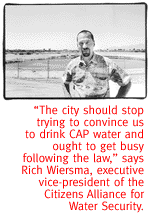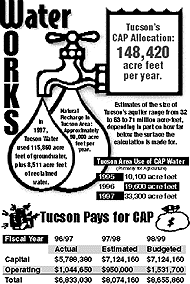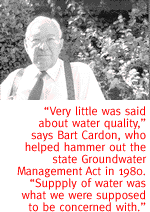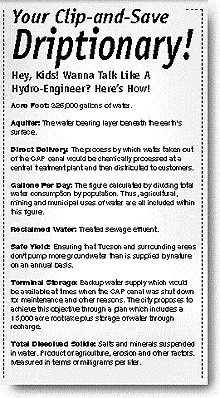
IN 1993, MASSIVE flooding changed the course of the Mississippi
River. The same year, Colorado River water poured into Tucson's
delivery system, arriving in thousands of Tucson homes and businesses
as a brown, stinky brew that blew out pipes. But unlike the Mighty
Mississippi, the future course for direct delivery of Central
Arizona Project water hasn't changed at all.
In 1995, 41,000 people--more than 56 percent of the voters--demanded
a change in the direction for CAP water when they supported Proposition
200, the Water Consumer Protection Act. In 1997, 46,000 voters--59
percent of the total--repeated that demand even louder. But the
course of treated Colorado River water remains the same as it
did in 1993: It is almost certainly headed back to our homes.
Since the passage of the Water Consumer Protection Act, the city
government has done very little to abide by the spirit of the
law. Of the $88 million attributed to the Act in the Capital Improvement
Program budget for the next fiscal year, almost 95 percent will
implement projects planned long before the adoption of Proposition
200.
 In 1996 the Tucson City Council did, however, adopt a resolution
in response to the Water Consumer Protection Act: "The Mayor
and Council of the City of Tucson hereby reaffirms its commitment
to the enhanced treatment and direct delivery of high-quality
water, including Central Arizona Project water, consistent with
the water quality requirements of Proposition 200 as an important
component of the City's overall water resources plan, and for
the development of an implementation plan for such treatment and
delivery which will successfully accomplish the direct use and
terminal storage of CAP water."
In 1996 the Tucson City Council did, however, adopt a resolution
in response to the Water Consumer Protection Act: "The Mayor
and Council of the City of Tucson hereby reaffirms its commitment
to the enhanced treatment and direct delivery of high-quality
water, including Central Arizona Project water, consistent with
the water quality requirements of Proposition 200 as an important
component of the City's overall water resources plan, and for
the development of an implementation plan for such treatment and
delivery which will successfully accomplish the direct use and
terminal storage of CAP water."
But Proposition 200 encourages alternative, non-drinking uses
for CAP like recharge or use by farms and mines, not the direct
use of CAP water. In addition, the need for a terminal storage
lake was eliminated with the passage of the act.
 If CAP water is to be supplied to households while the Water
Consumer Protection Act is in place, the law sets quality standards
similar to those of existing groundwater from Avra Valley. But
the city's policy calls simply for "enhanced treatment"
of CAP water without defining what that is. The resolution shows
just how ambivalent water policy in our community has become in
the last few years.
If CAP water is to be supplied to households while the Water
Consumer Protection Act is in place, the law sets quality standards
similar to those of existing groundwater from Avra Valley. But
the city's policy calls simply for "enhanced treatment"
of CAP water without defining what that is. The resolution shows
just how ambivalent water policy in our community has become in
the last few years.
A DECADE AGO, the course of local water planning was much more
straightforward. The state's Groundwater Management Act of 1980
required the city to meet the goals of "safe yield"
by 2025. The law focused on the quantity of water to be used,
not its quality.
"Very little was said about water quality. Supply of water
was what we were concerned with," says Tucsonan Bart Cardon,
one of eight people who hammered out the groundwater law in a
long series of closed-door sessions. He remembers another detail
from the discussion: "Golf courses were hands off. Nobody
talked about interfering with development and growth."
It's no surprise that water quality wasn't an issue in those
negotiations. CAP water was not going to be much different in
total dissolved solids (TDS) than the surface water being served
in the Phoenix area, so it was assumed that if the water was fit
for Phoenicians, Tucsonans would accept it too.
In Tucson, however, there would be a substantial difference in
TDS. Tucson's groundwater has a TDS level of around 300 parts
per million. Canal water weighs in at approximately 750 parts
per million. The difference was known to cause problems. One report
summarized the situation: "The urban user (of Colorado River
water) incurs additional costs due to more frequent replacement
of plumbing and water using appliances, use of water softeners
and the purchase of bottled water."
But elected officials and others making decisions about Tucson
water issues in the 1980s heard only that the public preferred
not to improve the quality of CAP water--a conclusion based on
a phone survey of 400 households.
Most of those responding to the survey did not want to pay more
for quality treatment at a central water plant. But then, they
weren't told about the composition of CAP water, or what it would
do to their plumbing.
Those additional, ongoing costs were never explained to Tucsonans.
Instead, as one University of Arizona author wrote, "Water
officials...tended to argue that whatever inconveniences result
from the slight decrease in water quality is more than compensated
for by having access to this new water source."
 Then came the summer of 1993. Bursting water pipes and thousands
of irate citizens eventually forced the City Council to turn off
CAP, at least temporarily.
Then came the summer of 1993. Bursting water pipes and thousands
of irate citizens eventually forced the City Council to turn off
CAP, at least temporarily.
But to this day, a majority of the Council still does not give
water quality serious consideration. Instead, they continue to
go by the book: "The Tucson Water Resource Plan 1990-2100,"
which focuses only on the quantity of supply and the cost of delivering
water. The quality issue is ignored.
When work began on preparing the long-range plan in 1988, some
basic objectives were obvious. The need to accommodate 2.8 million
people in the metropolitan area by 2100 meant that Tucsonans would
begin drinking treatment plant-processed Central Arizona Water
very quickly.
The water plan had five primary goals. They were to 1) comply
with the Groundwater Management Act while 2) reducing groundwater
pumpage as soon as possible. The plan also sought to 3) maximize
the use of CAP water, to 4) reuse or store effluent and 5) "to
be flexible in responding to changing conditions."
The goals of the plan were based on several key assumptions which
quickly proved incorrect. The predicted extremely rapid rate of
population increase didn't occur; and Tucson Water never became
the only provider of water in the region. Instead, a number of
upstart water companies have emerged since 1989.
The plan also assumed CAP water would flow smoothly through the
city's water delivery system. The cost of that mistake alone totals
in the tens of millions of dollars.
The planners also hoped conservation would continue, with a substantial
increase in effectiveness. Eventual water usage would be reduced
from 160 to 138 gallons per day per capita. In reality, water
use has been increasing for the past few years, up to 171 gallons
a day in 1996 and 169 gallons in 1997.
The "Beat the Peak" program is now perceived by many
Tucsonans as a sham, intended to give water to new suburbs for
more swimming pools, golf courses and lawns. As County Supervisor
Sharon Bronson puts it: "Right now people say, 'Why should
we conserve, when conservation means greater increases in population
and a decrease in our quality of life?' "
 But there is one assumption from the plan that has not changed
since 1989. Everyone knew then the cost of the CAP delivery system
needed to accommodate new population growth would be spread out
over existing Tucson Water customers.
But there is one assumption from the plan that has not changed
since 1989. Everyone knew then the cost of the CAP delivery system
needed to accommodate new population growth would be spread out
over existing Tucson Water customers.
Although newcomers would require the new water facilities, there
was no thought of charging some kind of water impact fee on new
homes. Instead, the only impact fee the city government would
charge ironically turned out to be the one levied on current homeowners
and businesses by the CAP's property damage.
The 1989 plan recommended a variety of sources to meet the demand
for water in both the short and long term. Through 2025, direct
delivery of CAP water was to be the primary supply.
After that, excess CAP water which had been recharged for storage
purposes in places like Avra Valley would be recovered. Additionally,
reclaimed sewage effluent would eventually be treated for use
as drinking water. And a return to large-scale groundwater pumping
was scheduled to begin after 2025.
THE LOCAL WATER policy landscape has obviously changed
dramatically since the adoption of the long-range water plan.
The most notable change has been voter approval of the Water Consumer
Protection Act.
Before the passage of the proposition, the central part of the
city was nowheresville to Tucson's big-money people, who made
their profits by developing for new population growth on the fringe
of the community. But to many of us it was home, and still a place
of pride. The vast majority of Tucsonans voted to back their town
when they overwhelmingly supported Proposition 200.
For the past three years, the public, through the ballot box,
has played a role in the process of determining water quality.
But the end may be in sight: The provisions of Proposition 200
might be terminated in November of 2000 with voter approval.
As Deputy City Manager John Nachbar puts it, "The strongest
interpretation (of Proposition 200) is that the heart of the Water
Consumer Protection Act goes on indefinitely until the voters
decide otherwise. That means no direct delivery of CAP that is
not at Avra Valley standards."
 But that hasn't stopped the city from devising a scheme intended
to send CAP-like water back to our homes. At the same time, the
water projects the city is now implementing can easily be converted
for the direct delivery of CAP water if that becomes possible
again.
But that hasn't stopped the city from devising a scheme intended
to send CAP-like water back to our homes. At the same time, the
water projects the city is now implementing can easily be converted
for the direct delivery of CAP water if that becomes possible
again.
The majority of the City Council--Mayor George Miller and councilmembers
Shirley Scott, Janet Marcus and now Fred Ronstadt--are very careful
about which water projects they support. Projects which can't
be used for the direct delivery of CAP water just don't get funded.
Miller declared in a 1996 letter that the city intends to resume
direct delivery of canal water "within the next five years."
Only last month, he again said that the city's ultimate goal was
the direct delivery of CAP water to Tucson Water customers.
"I think the majority of the Mayor and Council definitely
hope that (Proposition 200) will go away," says City Councilmember
Jerry Anderson, an opponent of direct delivery. "They hope
that with a very positive public-relations campaign they can convince
the community they're recharging and doing what the proposition
specified...I think with the sunset of Proposition 200 in the
next few years, we will see a return to direct delivery of CAP."
IF THAT HAPPENS, the question of who'll bear the individual cost
of CAP water will have to be answered. With the experience of
bursting pipes and appliances in 1993 and 1994, the debate over
who should pay the price for the relatively poor quality of CAP
will once again become an important community issue.
Those indirect, or "hidden," costs of CAP can range
from a few dollars to several thousand per household. As the 1993
experience showed, the impact of the water is impossible to predict.
Despite that, the city government constantly proclaims that its
aggressive program to replace 200 miles of water mains will do
much to fix the water-quality issue. According to them, it is
simply "the brown water problem."
But what about the hundreds of miles of pipes in our homes, especially
the older ones? There is only silence from the city. No provision
has been made for counteracting the severe damage that will result
from the reintroduction of CAP water.
 A number of elected officials and others continue to push against
the rising tide of public opinion. They advocate for a return
to CAP for drinking purposes.
A number of elected officials and others continue to push against
the rising tide of public opinion. They advocate for a return
to CAP for drinking purposes.
Carol West, the director of the Tucson Regional Water Council,
says her group believes that direct delivery is more efficient
and cost-effective than other potential uses of the water.
"People may not oppose direct delivery (of CAP water) if
they are assured it will be of high quality," says Lois Kulakowski
of TRWC. She knows the public expects to continue drinking groundwater,
but she believes there is no chance the quality of CAP water will
be improved through recharge.
TRWC, which last year supported the repeal of Proposition 200,
wants to see a voluntary pilot re-introduction of CAP water sometime
after 2000. The group believes the test should only occur if incentives
like reduced water rates are offered to the affected customers.
The city would also have to assure it would respond quickly to
any problems caused by the return to CAP water.
West believes the water-quality standard for this pilot project
should be determined by the community through the city's "At
the Tap" project. That $658,000 public relations program
is expected to be completed later this year.
Rich Wiersma, a longtime opponent of direct delivery and the
executive vice-president of Citizens Alliance for Water Security,
adamantly disagrees with TRWC. He dismisses "At the Tap"
as "just another way for the city to try to convince people
that chemically treated CAP water is what we want to drink. The
city should stop trying to convince us to drink CAP water and
ought to get busy following the law (Proposition 200)."
WIERSMA THINKS THE city, by not using most of its current
CAP allocation, is wasting the water. He'd like to see some of
the CAP water the city presently isn't using recharged in streambeds
like the Rillito. One of the advantages of recharging CAP now,
Wiersma says, is that the river water could be quickly put to
use by storing it in the aquifer.
The late George Barr, a longtime member of the state's Central
Arizona Water Conservation District Board of Directors, was an
outspoken critic of city water policies. He thought the quality
of CAP water would undoubtedly be improved by recharging it in
streambeds. In 1995 he observed, "The dilution effect of
mixing 60,000 acre feet per year into a 60,000,000 acre foot groundwater
reservoir is so large that it would take decades to make an impact
on the salinity of the groundwater."
 Austin Nuñez, the chairman of the San Xavier District
for the past 11 years, takes a different perspective on the use
of CAP. Because of severe groundwater overpumping, hundreds of
sink holes and dry wells have occurred on Tohono O'odham land
south of town, devastating the farming community.
Austin Nuñez, the chairman of the San Xavier District
for the past 11 years, takes a different perspective on the use
of CAP. Because of severe groundwater overpumping, hundreds of
sink holes and dry wells have occurred on Tohono O'odham land
south of town, devastating the farming community.
Asked if the Tohono O'odham are in support of direct delivery
for Tucson Water customers, he replies, "That's a tough one.
If the treatment plant issue and the corroding of the pipes hadn't
been the case, we had hoped the city would use CAP water for all
its domestic water use.... People need to make sure that they
find a way to replace groundwater that is depleted. It does affect
us, in that every drop that is taken out depletes our area."
Today, the community is in a holding pattern over these water
quality issues, without any leadership from the City Council.
The majority--Miller, Marcus, Scott and Ronstadt--votes to implement
projects in the name of Proposition 200, but those projects can
easily be used to return to direct delivery of CAP when expedient.
Tucson's elected officials have also failed to update the 1989
water plan to reflect today's new realities. Instead, they have
responded through a public relations campaign to advertise their
"recharge" projects.
What these ads don't say, of course, is that those projects were
planned long before the adoption of the Water Consumer Protection
Act. This kind of deceptive advertising only adds to the appearance
that the City Council is stalling in hopes that Proposition 200
will go away.
But our water quality debate hasn't run dry. While the water
experts and the daily papers urge us to accept lower standards,
there's still a chance the City Council will change course and
find a way to use CAP water without forcing it into our pipes--and
down our throats.
Next week: The Weekly examines the city's CAP water projects
and other options which could abide more closely to the intent
of the Water Consumer Protection Act.
Molly McKasson served on the Tucson City Council from 1989 to
1997. Dave Devine is a frequent contributor to The Weekly.
Both endorsed Proposition 200 and continue to support it.

|





